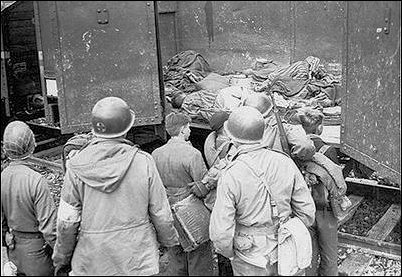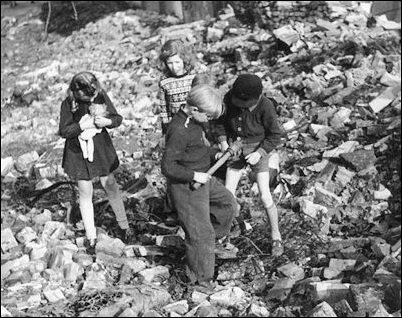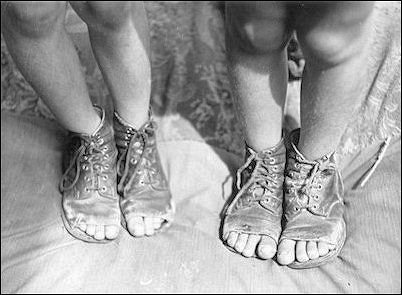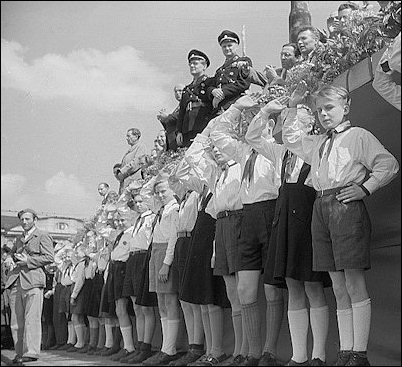![]()

Aftermath
Nuremberg and Beyond
Months before the end of the war, Allied troops plunging first into Poland and later into Germany came upon sights that made battle-hardened men weep. The liberation of concentration camps in Germany and extermination centers in occupied Poland shocked the unprepared troops who entered them.
On April 12, 1945, Generals Eisenhower and Patton visited Ohrdruf, a sub-concentration camp of Buchenwald, the first camp liberated on the Western Front. After viewing the carnage and listening to accounts by survivors, Eisenhower insisted that a filmed record be made, saying he believed that in the future there would be those who would say such things never happened, given the magnitude of the crimes.
A few weeks later, Dachau, located near Munich, was liberated by Americans who became so enraged at what they found that they began conducting on the spot executions of captured SS men until they were halted by senior American officers.
Allied soldiers then made a practice of forcing captured Hitler Youths and nearby townspeople to view the carnage inside liberated camps up close and also made them bury piles of decomposing, emaciated corpses. Germans not living near the camps, especially young people, were later forced to watch Allied documentary films at their local theaters.
The scope of Nazi mass murders committed throughout Europe soon gave rise to the question of justice. The SS itself was declared a criminal organization. All over Germany, surviving Nazi leaders were hunted down. The Hitler Youth organization, however, was written off by the Allies as consisting of misled young people. Therefore, as a group, its members were not targeted for prosecution.
On November 20, 1945, the first Nuremberg War Crimes Trial began with four Allied nations (Soviet Russia, USA, Great Britain, France) charging 22 principal Nazi leaders with crimes against peace, against humanity, and against defenseless civilians. Former Hitler Youth Leader Baldur von Schirach was among those charged.
Evidence included the Allied films of concentration camps showing scenes such as a bulldozer pushing enormous piles of bodies into a mass grave. The footage had an extraordinary effect on the accused Nazis, directly confronting them for the first time with the atrocities of Hitler's regime, and also with the realization that they would likely hang for such offenses.
Witnesses for the prosecution included Auschwitz Commandant Rudolf Höss and Hermann Graebe, a German businessman who stunned the courtroom with his first-hand account of an SS Einsatz unit systematically shooting Jewish families in Lithuania.
To the surprise and scorn of his fellow Nazis, Baldur von Schirach expressed remorse upon taking the witness stand, bitterly denouncing Hitler and labeling Auschwitz as "the most devilish mass murder in history."
"The murders were ordered by Adolf Hitler," Schirach testified. "That can be seen from his last testament. That last testament is genuine. He and Himmler together committed that crime which for all times is the darkest blot on our history. It is a crime which is shameful to every German."
"It is my guilt," said Schirach, "which I will have to carry before God and the German nation, that I educated the youth of that people; that I raised the youth for a man who, for many years, I considered impeccable as a leader and as a head of state; that I organized youth just as I did. It is my guilt that I educated German youth for a man who committed murder by the millions."
Schirach had also overseen the deportation of 65,000 Jews from Vienna to ghettos in occupied Poland, following his appointment as Gauleiter (Nazi Governor) of Vienna. Evidence against Schirach included a speech he had given in 1942 stating that the "removal" of Jews to the East would "contribute to European culture."
On October 16, 1946, sentences were handed down. Schirach got twenty years, found guilty of crimes against humanity for educating German youth in the spirit of National Socialism and subjecting them to an extensive program of Nazi propaganda. Eleven former top Nazis including Hermann Göring were sentenced to be hanged.
Life Among the Ruins
Outside of the courtroom and throughout Germany, people hardly took notice of the fate of their once-vaunted leaders. They were now engaged in a desperate daily struggle for survival. Germany and much of Europe lay in absolute ruins following Hitler's war, the most destructive conflict in the history of humanity, in which an estimated 50,000,000 persons had died. For the average German, basic necessities such as food, water, and a safe place to sleep, were now the overriding concerns.
Living among the ruins, former Hitler Youths used survival skills they had learned during the war to stave off starvation. They became efficient scavengers, always looking for bits of coal and wood for heating their homes, and delighted in stealing food and cigarettes, or anything, from American soldiers.
In October 1945, compulsory schooling was reintroduced, in part just to get them all off the streets. Most of them had been poorly educated during Hitler's Reich. When school resumed, it was not unusual to see 16 and 17-year-olds sitting in grammar school classrooms.
Among university students there was now a great thirst for knowledge. German universities had once been ranked among the finest in the world. Now, absent the corrupting influences of Nazi ideology, students once again devoured reliable knowledge and instruction.
Postwar Germany itself was divided in half – with the western portion placed under American, British and French jurisdiction. East Germany came under the control of Soviet Russia. Remnants of the Hitler Youth in communist East Germany eventually became the FDJ, the Free German Youth, trading their brown uniforms for new blue uniforms and marching under Soviet Unity Party banners amid pictures of Hitler's former nemesis, Josef Stalin.
Divided Germany became the front line in a new conflict, the Cold War, between the two postwar superpowers, the United States and Soviet Russia, casting a shadow over the lives of all Germans until the collapse of the Soviet Union and reunification of Germany in 1990. The demise of communism in East Germany ended the long era of mandatory participation in state-sponsored political youth groups, freeing young Germans to join any traditional group they pleased or belong to none at all.
Copyright © 1999 The History Place™ All Rights Reserved
Hitler Youth Timeline
and Organization Info
The History Place - Hitler Youth: Author/Bibliography
The History Place - Hitler Youth Index Page
See also: The History Place - Personal Histories
From Hitler Youth to U.S. Air Force - Personal History of Hubert Schmidt
See also: The History Place - Adolf Hitler (62 chapters)
Part I - The Rise of Adolf Hitler
Part II - The Triumph of Hitler
Part III - The Defeat of Hitler
[ The History Place Main Page | Timeline of World War II in Europe | Holocaust Timeline | Speech of the Week | Photo of the Week | This Month in History | Books on Hitler's Germany | Send Feedback ]
Terms of use: Private home/school non-commercial, non-Internet re-usage only is allowed of any text, graphics, photos, audio clips, other electronic files or materials from The History Place.



